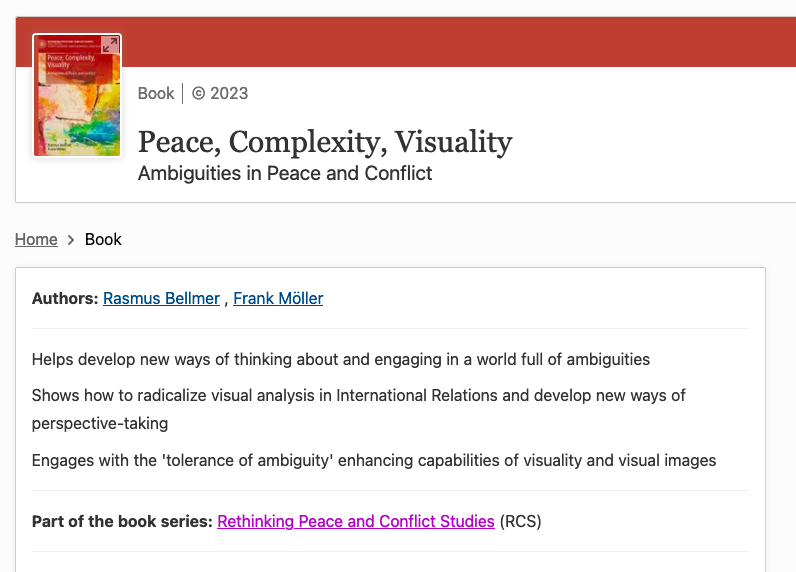We are proud to announce that Palgrave Macmillan has published our book Peace, Complexity, Visuality: Ambiguities in Peace and Conflict this week. In preparation for the book’s release, we published blog posts introducing the book’s different parts.
In Peace, Complexity, Visuality, we argue that we can capitalize on the tolerance of ambiguity enhancing potentialities inherent in visual images – their non-coherence – and thus increase our capability of tolerating ambiguities. Crucially, in a world saturated not only with ambiguities but also with visual images, it is mandatory to think ambiguity and visuality together. We analyze the constructive and peaceful potentialities of ambiguities through an exploration of journalistic imagery in the context of post-war Bosnia and post-siege Sarajevo.
In earlier blog posts, we introduced part I, part II and part III of the book.

In the book’s final part, titled Leveraging Ambiguity for Peace, we slightly increase the distance between our argument and our case study by addressing, in chapter ten, politics and society in terms of difference rather than sameness and identity. Western discourse deems difference problematic, a danger or a challenge, sometimes even a source for violence and war. However, social conflict offers many possibilities to deal with difference constructively: it can serve the improvement of social interaction among and between different social groups. In the chapter, we show why we consider embracing difference a relevant resource for peaceful change, first against the backdrop of the Bosnian and the Sarajevan context and then in regard to more general and (photo-)philosophical reflections.
In chapter eleven, we explore the surround – peripheral image components – as a place for alternative meaning making and knowledge production. We note that interpretive-hermeneutical approaches to image analysis may increase the invisibility of some image components by emphasizing others. Visibility and invisibility thus do not simply follow patterns of inclusion in and exclusion from the frame linked to an inside and an outside, respectively, as the literature on representability tends to argue. Analysis of the surround shows that the outside may be inside. It may increase our knowledge of both the scenario depicted and photography’s role in it and, therefore, perform a critical function. The surround offers alternatives to merely unimaginatively accepting or rejecting established designations of meaning.
In chapter twelve, we explore the potential contributions of images to international peace mediation. Inspired by the concept of active listening and narrative approaches to mediation, we advance the notion of active looking in peace mediation as a visual-discursive practice that includes images as a mode of expression and contribution to meaning-making processes, capitalizing on specific characteristics of images, especially as regards their relationship to verbal language. We propose active looking as an approach to conflict mediation and as a mediation skill derived from an understanding of conflict transformation that – instead of aiming at problem-solving based on sameness – appreciates openness, difference and ambiguity.
Concluding the book, we ask in chapter thirteen: What are the limits of tolerance? Is our case study well chosen? Do we create new binaries strictly distinguishing tolerance of ambiguity from disambiguation and visual-narrative simplification from complexification?
The book can be accessed and purchased here.

